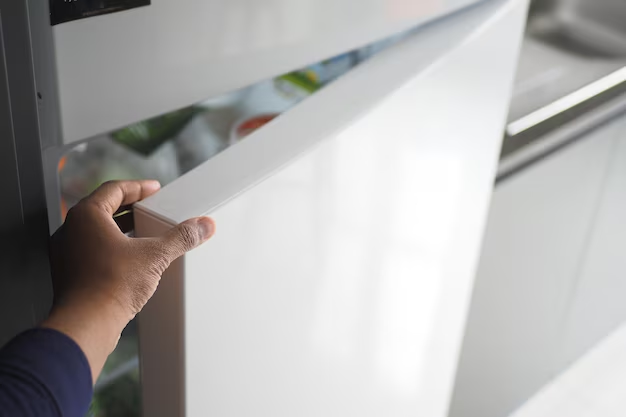Optimal Refrigerator Temperature: Keeping Your Food Fresh and Safe
Imagine reaching into your refrigerator and pulling out a fresh, crisp apple, or finding your milk perfectly chilled and ready to pour into your cereal. Setting the right temperature for your refrigerator is not just about enjoying the best taste and texture from your food; it’s crucial for food safety and extending the shelf life of perishable items. In this article, we’ll explore the ideal refrigerator temperature, why it matters, and how you can ensure your fridge is performing optimally.
Understanding the Ideal Refrigerator Temperature
The U.S. Food and Drug Administration (FDA) recommends that your refrigerator be set at or below 40°F (about 4°C). This temperature is considered the sweet spot for keeping food both fresh and safe. Let’s delve into why this particular setting is crucial.
🌀 Why 40°F is the Magic Number
Bacteria Growth Prevention: At temperatures above 40°F, bacteria can multiply quickly, leading to spoilage and potential foodborne illnesses. Keeping your refrigerator at or below this temperature slows down this process, ensuring your food remains safe to eat.
Food Longevity: Many refrigerated items stay fresh much longer when stored at the proper temperature. This means less food waste and more savings for you.
Consistency: Maintaining a consistent temperature prevents food from being exposed to fluctuating conditions, which can degrade quality over time.
Ensuring Your Refrigerator Stays Cool
Now that we understand the why, let's talk about the how. Ensuring your refrigerator maintains an optimal temperature requires a bit of attention and maintenance. Here’s how you can keep things cool:
🌡️ Monitoring and Adjusting Temperatures
Use a Thermometer: While most modern refrigerators have built-in thermometers, it’s a good practice to use an external fridge thermometer to accurately monitor the temperature. Place the thermometer in the middle of your refrigerator for the best reading.
Regular Checks: Make it a routine to check the temperature weekly. Temperature settings can drift over time, and occasional checks can ensure everything is running smoothly.
📏 Proper Fridge Organization
Avoid Overloading: Overpacked refrigerators can restrict air circulation, causing uneven cooling and potentially warmer spots where bacteria can thrive.
Organized Shelves: Store ready-to-eat foods on upper shelves and raw foods on lower shelves to prevent cross-contamination. Keep your veggies in the crisper and milk in areas with consistent cooling, like the back of a middle shelf.
Space Management: Leave some space between items to allow cold air to circulate effectively.
🔍 Regular Maintenance
Check Seals: Door seals can wear out over time, allowing cold air to escape. Regularly inspect and clean the seals to ensure they’re intact.
Defrost When Necessary: If your refrigerator isn’t frost-free, it’s essential to defrost it periodically to maintain peak efficiency.
Clean Coils: Dust and dirt on your refrigerator coils can affect its efficiency. Cleaning them twice a year can help maintain optimal temperature and reduce energy consumption.
Related Subtopics for Deep Diving
Beyond just keeping your fridge at the right temperature, there are several related factors and tips that can enhance your refrigerator’s efficiency and your food’s longevity.
🧊 Freezer Considerations
Your refrigerator freezer is an equally important component of the food storage process. The ideal temperature for your freezer is 0°F (-18°C). This ensures that your frozen goods remain solid and free from ice crystals that can damage food texture and flavor.
- Avoid Freezer Burn: Proper packaging is key. Use airtight containers or heavy-duty freezer bags, and remove as much air as possible.
- Never Overfill: Just like your fridge, your freezer needs space for air circulation.
🌱 Energy Efficiency Tips
A well-maintained refrigerator can save you money not only by preserving your food but also by lowering energy bills. Here are a few tips:
- Energy Star Models: Consider upgrading to an Energy Star-rated refrigerator, which uses less electricity and saves on utility costs.
- Location Matters: Place your fridge in a cooler area of your kitchen, away from direct sunlight or heating appliances.
- Optimal Usage: Keep the refrigerator door closed as much as possible to maintain a stable temperature.
Practical Takeaways: Making the Most of Your Refrigerator
To wrap up, here are some quick and practical tips to keep your refrigerator running efficiently and your food fresh:
🧊 Optimal Temperatures: Keep your fridge at or below 40°F and your freezer at 0°F.
📏 Smart Organization: Arrange items to allow for proper air circulation and reduce cool air loss.
🔍 Routine Maintenance: Regularly check and clean the seals and coils to ensure energy efficiency.
🌡️ Monitor Temperatures: Use an internal thermometer for accurate readings.
📅 Scheduled Checks: Make checking and adjusting fridge settings a regular task, like grocery shopping day.
🌀 Energy Efficiency: Position your refrigerator away from heat sources and consider an energy-efficient model where possible.
Keeping your refrigerator at its recommended temperature is a crucial step in ensuring both food safety and efficiency. With the right knowledge and a bit of regular maintenance, you can enjoy fresh, safe, and delicious meals every day. By managing your refrigerator’s temperature settings and maintaining it properly, you're not just taking care of your food; you’re also being an environmentally conscious and budget-savvy household manager.
